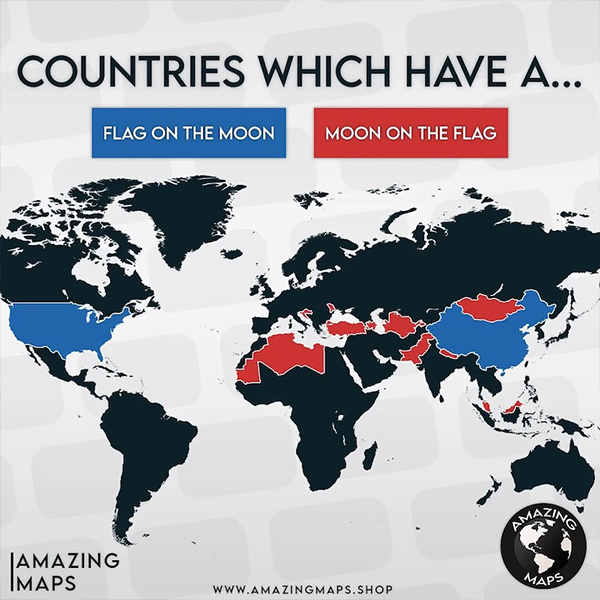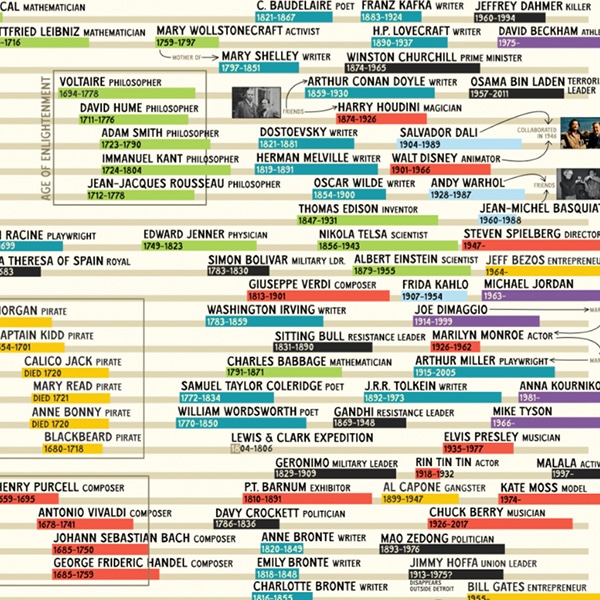
Throughout the 1920s and 30s, “outlines” were gaining popularity. Dominating nonfiction book publishing, the trend sought to democratize knowledge, distilling subjects like philosophy, physics, and medicine into more digestible and approachable formats. It didn’t take long for John B. Sparks, an English engineer, bacteriologist, and historian, to join the movement and create his very own “outline.”
First printed by Rand McNally in 1931, the Histomap condenses more than 4,000 years of world history into a vibrant, densely packed infographic. The design primarily revolves around several multi-colored streams, all ebbing and flowing into one another as time continues its endless march toward the present day. Each stream traces the evolution of different civilizations, starting at 2000 BCE. with the Aegeans, Egyptians, Hittites, Amorites, Iranians, Indians, Huns, and Chinese. Eventually, as our eyes travel across the 5-foot-long map, various societies swell while others are swallowed up, illustrating what Sparks called the “relative power of contemporary states, nations, and empires.”
As a historical object, the Histomap is still impressive nearly a century later, especially when considering the amount of information it’s able to convey. Today, we can crawl the Internet for answers and resources, scouring a centralized database without even having to read through individual books. In the early 1900s, “outlines” served as a sort of proto-Internet, attempting to assemble and classify facts into one comprehensive unit. In that way, the Histomap can perhaps be understood as a smart phone, meant to accompany its owner wherever they went. In fact, the map was originally sold and packaged in a neat, green sleeve that could easily unfold when on-the-go, much like a portable roadmap.
It’s no question that the Histomap is an accomplishment in graphic and informational design. Even so, it does also reveal 20th-century attitudes toward domination, racial groups, and imperialism. The map’s Y-axis is easy enough to interpret: it indicates time. The X-axis, on the other hand, is more opaque, seemingly reflecting the “size” of each empire. How Sparks interpreted that “size” is equally unclear. Was a civilization’s width on the map determined by how many subjects or the amount of territory it had? Its artistic or cultural legacy, or perhaps its geopolitical influence? Its wealth? Its military prowess?
This flaw is best captured by how Eurocentric the map is, with little space reserved to civilizations and societies from Africa and the Americas before the Europeans colonized the “New World” in the 15th century. The fine differences between cultures are also reduced, neatly grouped into various and often racialized “peoples,” as was common at the time.
“Clear, vivid, and shorn of elaboration, [the] Histomap holds you enthralled as you follow the curves of power down time’s endless course,” the map’s front cover reads. “Here is the actual picture of the march of civilization, from the mud huts of the ancients through the monarchistic glamor of the middle ages to the living panorama of life in present day America.”
Sparks didn’t stop at the “march of civilization,” though. He made similar charts dedicated to religion and evolution, both just as dizzying and as packed as the Histomap.
To explore a digital version of the Histomap in greater detail, visit Yale University Library.
In 1931, John B. Sparks created the Histomap, condensing more than 4,000 years of world history into a vibrant infographic. (Click image to enlarge.)
Sources: The histomaps, four thousand years of world history; Infographic: 4,000 Years Of Human History Captured In One Retro Chart; The Entire History of the World—Really, All of It—Distilled Into a Single Gorgeous Chart; The History of the World in One Beautiful, 5‑Foot-Long Chart
Related Articles:
Dive Into Over 10,000 Historical Children’s Books Thanks to This Fascinating Database
The Undecipherable Voynich Manuscript Can Be Viewed Online in Its Entirety
Fascinating Cross-Section Shows Over 4,000 Years of an English Highway’s History























































































